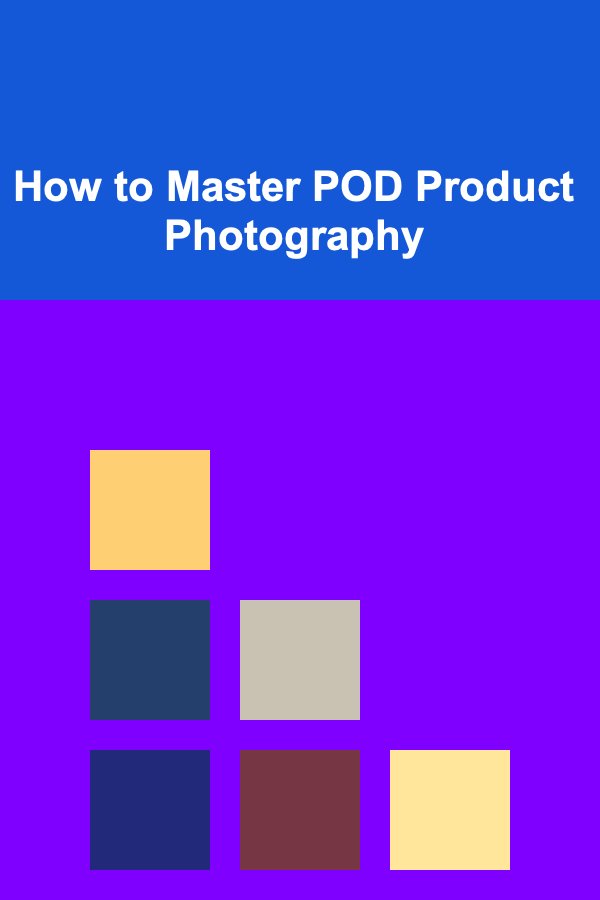
How to Master POD Product Photography
ebook include PDF & Audio bundle (Micro Guide)
$12.99$11.99
Limited Time Offer! Order within the next:

In the world of Print on Demand (POD) businesses, creating visually compelling product images is critical to your success. The way your product looks online is often the first impression potential customers will have of your brand. High-quality product photography can set your shop apart from the competition and convert views into sales. While you don't need to be a professional photographer to capture great POD images, mastering a few key techniques can make a significant difference in how your products are perceived.
In this guide, we will explore the process of mastering POD product photography, covering everything from equipment choices to lighting techniques, and composition tips to editing. By the end of this article, you'll be equipped with the knowledge to take your POD product photos to the next level.
Understanding the Importance of Product Photography for POD
Before diving into the technicalities, it's important to understand why product photography is so crucial for your POD business. In eCommerce, the image is often your product's first interaction with potential customers. It needs to do several things:
- Grab Attention: Your product photo needs to stand out and attract attention amidst a sea of other listings. A high-quality, well-composed image is more likely to catch a customer's eye than a poorly lit or badly shot one.
- Build Trust: Clear and professional images convey that your brand is reliable. Customers expect a high standard of presentation, and failure to meet those expectations can make them hesitant to buy from you.
- Showcase Product Features: Great product photos allow customers to clearly see what they are purchasing. High-quality images highlight the design, quality, and details of the product.
- Reflect Your Brand's Aesthetic: The way you present your products speaks volumes about your brand identity. Professional-looking product photos can align with your brand's values and aesthetics, helping to create a cohesive brand experience.
Key Elements of Effective POD Product Photography
To capture product photos that sell, there are several key elements you need to focus on. These include choosing the right equipment, utilizing proper lighting techniques, arranging your product in an appealing way, and editing your images to perfection. Let's dive into each of these elements in more detail.
1. Equipment Selection
While it's possible to take product photos using a smartphone, investing in the right equipment can significantly improve your photography results. Here are the essential pieces of equipment to consider:
Camera
The camera you choose will largely depend on your budget. While smartphones have improved significantly in recent years, a dedicated DSLR or mirrorless camera can provide superior image quality. Cameras with at least 20-24 megapixels will provide sufficient resolution for clear, sharp product images.
Lens
The lens you use is also critical for product photography. A 50mm or 35mm lens with a wide aperture (such as f/1.8 or f/2.8) is often ideal for product photography, as it allows for a shallow depth of field. This creates a beautiful background blur, helping the product to stand out in the shot.
Tripod
A tripod is essential for keeping your camera stable and ensuring that your photos are sharp. It also allows you to experiment with different angles without worrying about shaky hands.
Backgrounds and Props
For POD product photography, your background and props should complement your product, not overshadow it. Neutral-colored backgrounds (white, grey, beige) are popular choices because they allow the product to take center stage. Depending on your product, you might also consider using props that add context or tell a story without cluttering the frame.
Lighting
Lighting is arguably the most important element in product photography. Great lighting can make a low-budget product look premium, while poor lighting can undermine even the best product. We'll explore lighting in more detail below.
2. Lighting Techniques
The right lighting can transform your product photos, making them look professional and polished. In fact, lighting might be more important than the camera itself. Here are some of the best techniques to master product lighting:
Natural Light vs. Artificial Light
- Natural Light: This is the most accessible and cost-effective form of lighting. Natural light is soft, flattering, and generally easy to work with. The key is to shoot your products near a large window where the light is diffused. However, be cautious of harsh direct sunlight, as it can create unflattering shadows.
- Artificial Lighting: If you're shooting indoors and can't rely on natural light, you can use artificial lighting setups. Softboxes and ring lights are popular choices for product photography. They create soft, even lighting that reduces harsh shadows and highlights.
Light Positioning
The position of your light source will dramatically affect how your product is illuminated. The most common lighting setup for product photography is the three-point lighting system, which uses three lights to create even, flattering illumination:
- Key Light: This is your main light source, positioned at a 45-degree angle to the product. It provides the primary source of illumination.
- Fill Light: A softer, secondary light that helps eliminate shadows created by the key light. This light is usually positioned opposite the key light.
- Backlight or Hair Light: A third light positioned behind the product helps separate it from the background, creating depth and preventing it from blending into the backdrop.
For a simple setup, you can use just a key light and a fill light. The backlight is optional but adds a professional touch.
Light Modifiers
Modifiers like softboxes, diffusers, and reflectors can help you control the quality of your light. A softbox diffuses the light, making it softer and less harsh, while a reflector bounces light back onto the product to fill in shadows.
3. Composition and Styling
The composition of your product photo is just as important as the lighting. A well-composed image draws the viewer's eye and highlights the product in the best possible way. Here are some composition tips to keep in mind:
Use the Rule of Thirds
The rule of thirds is a composition technique that involves dividing your image into nine equal parts (using two horizontal and two vertical lines). Positioning your product along these lines or at their intersections creates a balanced and visually appealing image.
Highlight Product Features
Your goal is to showcase the product in the best possible way. Make sure the key features are clearly visible. For clothing items, for example, ensure that details like logos, patterns, or fabric texture are in focus.
Consider Angles and Perspectives
Experiment with different angles to show your product in a unique way. For instance, shooting from a high angle can give a flat-lay effect, while shooting at eye-level can provide a more intimate look at the product. For 3D products like mugs, phones, or clothing, try shooting from multiple angles to show the depth and texture.
Use Props Wisely
Props can enhance the storytelling aspect of your product photos. For example, for POD apparel, consider using a mannequin or a model to showcase how the product looks when worn. For mugs, you might include a coffee table and some books to set the scene.
However, be mindful not to overuse props. They should complement, not distract from, the product itself. Ensure the props don't steal attention from the main subject.
4. Post-Processing and Editing
Even the best photos can benefit from post-processing. Editing allows you to fine-tune details like color balance, sharpness, and exposure. Here's a brief overview of editing steps you should consider:
Adjust Exposure and Contrast
If your image looks too dark or too bright, adjusting the exposure will correct it. Similarly, tweaking the contrast can help make your product pop by separating it from the background.
Crop and Straighten
Sometimes, your shot might need slight cropping to ensure the product is centered or to remove any distractions in the frame. Additionally, check the horizon and straighten the image if necessary.
Color Correction
Make sure the colors in your image match the real-life product. Many times, camera sensors don't capture colors perfectly, so use your editing software to correct any color imbalances.
Sharpen the Image
Applying a light sharpen filter will help bring out fine details in your product, ensuring it looks crisp and clear.
5. Best Practices for Different Product Categories
Different POD products may require different approaches to photography. Here are some specific tips for various product categories:
Apparel
- Mannequins or Models: Showcasing clothing on a mannequin or a model provides a sense of scale and helps customers visualize the product in real life.
- Flat Lay: A flat-lay style is great for showcasing T-shirts, hoodies, and accessories. Lay the clothing flat on a clean background, and shoot from directly above.
Mugs
- Lifestyle Shots: Include props like books, plants, or coffee beans to make the mug look more lifestyle-oriented.
- Close-Up: Ensure the design on the mug is clearly visible and focus on the details to highlight the print.
Phone Cases
- Angles Matter: Show the phone case from multiple angles to showcase its design, texture, and fit.
- Contextual Images: Include shots with a phone inserted into the case to demonstrate how it fits and looks in real life.
Posters and Prints
- Framing and Hanging: If selling wall art or posters, it's important to show the artwork framed or hung on a wall to give customers a sense of scale.
- Close-Up of Details: Focus on the texture of the paper or canvas to showcase the quality of the print.
Conclusion
Mastering POD product photography doesn't require a fancy camera or professional equipment, but it does take practice, patience, and attention to detail. By using the right equipment, mastering lighting techniques, understanding composition, and editing your images carefully, you can create product photos that sell. Whether you're a seasoned photographer or just starting out, the key to success in POD photography is consistency and quality. Keep experimenting with new ideas, refine your skills over time, and watch your POD business thrive.
Reading More From Our Other Websites
- [Small Business 101] Small Business Funding: Grants vs. Loans --- What's Best for Your Business?
- [Home Maintenance 101] How to Maintain Your Home's Water Softener for Optimal Performance
- [Personal Finance Management 101] How to Handle Financial Setbacks as a Family
- [Home Space Saving 101] How to Optimize Vertical Space: Creative Bookshelf Ideas for Small Rooms Beyond the Wall
- [Personal Investment 101] How to Use Real Estate Investment Trusts (REITs) to Grow Wealth
- [Personal Care Tips 101] How to Pair Teeth Whitening Strips with a Teeth Whitening Toothpaste
- [Home Staging 101] How to Incorporate Current Color Trends into Your Home Staging Strategy
- [Skydiving Tip 101] Choosing the Perfect Skydive Canopy: A Beginner's Guide
- [Home Pet Care 101] Dealing with Destructive Chewing in Dogs
- [Organization Tip 101] Best Basement Waterproofing Products for Long-lasting Protection

How to Keep Your Home Looking Beautiful and Tidy During the Holidays
Read More
How to Leverage Local Trends and Events in Your Dropshipping Ads
Read More
How to Stage Your Home's Windows to Maximize Natural Light
Read More
How to Use Mulch for Both Organization and Aesthetics
Read More
How To Support Children's Healthy Attachments
Read More
Renting with a Cosigner: A Checklist for Success
Read MoreOther Products

How to Keep Your Home Looking Beautiful and Tidy During the Holidays
Read More
How to Leverage Local Trends and Events in Your Dropshipping Ads
Read More
How to Stage Your Home's Windows to Maximize Natural Light
Read More
How to Use Mulch for Both Organization and Aesthetics
Read More
How To Support Children's Healthy Attachments
Read More